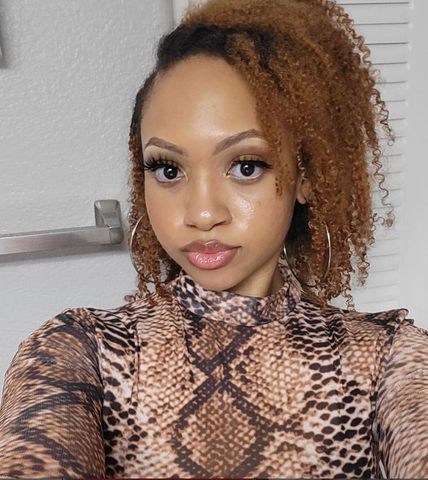What Is The Difference Between Thickness And Density?
Even though we tend to use these terms interchangeably, density and thickness each refer to different things. Learning the difference can help us get to know our natural hair better, and that additional knowledge can help us better care for our hair. So let’s dive right into the differences.
What is Density?
Density refers to the number of strands on your scalp. Whenever you’re referring to the fullness of your or someone else’s hair, you’re talking about density. You can determine if you have low or high density hair by taking a look at your scalp when your hair is parted. If your scalp is easily visible with little effort while parting, you probably have low density. If your scalp isn’t very visible and it takes a lot of effort to part your hair, you probably have high density hair.
What is Thickness?
Thickness refers to the diameter or size of your strands themselves. Whenever you’re referring to the coarseness or smoothness of your or someone else’s hair, you’re talking about thickness. You can determine whether your hair is thick or fine by holding a shedded strand between your fingers. If the strand is coarse or obviously textured and seems prominently sized, you likely have thick hair. If the strand is barely visible and smooth to touch, you likely have fine hair.

@fine_textured_glow
How To Care for The Different Combinations
Since these terms refer to different things, you can have a number of different combinations when it comes to density and thickness on your own head. It’s not as simple as being on one pole or the other; thickness and density are both sliding scales. But to keep things simple, we’ll walk through four possible combinations and how to care for them.
You could have thick, high density hair. This is hair that is coarse and full. It can be difficult to detangle or style hair with this combination, so things like working in small sections or regular stretching can help make maintenance a little easier.
You could also have thick, low density hair. This is hair that is coarse but not full. Naturals with this combination normally have the most issues with volume. Things like fluffing, picking, and diffusing can help remedy that.
On the other side of the spectrum, you could have fine, high density hair. This refers to hair that is full but not that coarse. Naturals with this combination can have difficulties with excessive breakage when styling and detangling. The best thing to do for hair with this combination is work in sections, be very gentle when styling or detangling, and avoid heavy or tight styles.
You can also have fine, low density hair. This is hair that is not coarse and not very full. Similar to thick, low density hair, naturals with this combination tend to have issues with volume. Since the strands are also fine, hair with this combination can be a little too delicate for fluffing and picking, especially if it’s excessive. Drying hair with a diffuser is a good gentle option.
It’s important to keep in mind that your hair can sometimes fall somewhere in the middle when it comes to density and/or thickness. So you could have hair that is fine with normal density, thick with normal density, normal thickness with high density, and normal thickness with low density as well. Because there are so many variations, it’s crucial that you fine tune your routine to your hair and your needs.
It’s also very important to remember that no matter your thickness or density, your natural hair is beautiful. It’s easy to get caught up wishing for hair that is different from our own. Everyday on social media we are inundated with images of natural hair influencers who have hair of all types, lengths, and thicknesses. The whole point of the natural hair journey is to celebrate your hair the way it grows out of your head naturally. But the truth is that it can be difficult sometimes. The best advice we can give is develop a regular routine that makes your hair feel healthy and cared for. The more time you spend with your hair, the better you’ll get to know it, the easier it will be to love it no matter what.
Which combination do you think you have? Share with us in the comments.


Leave a comment